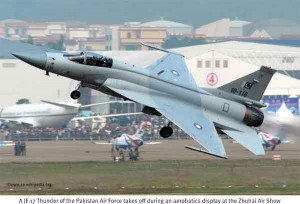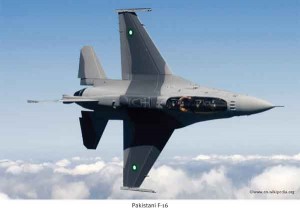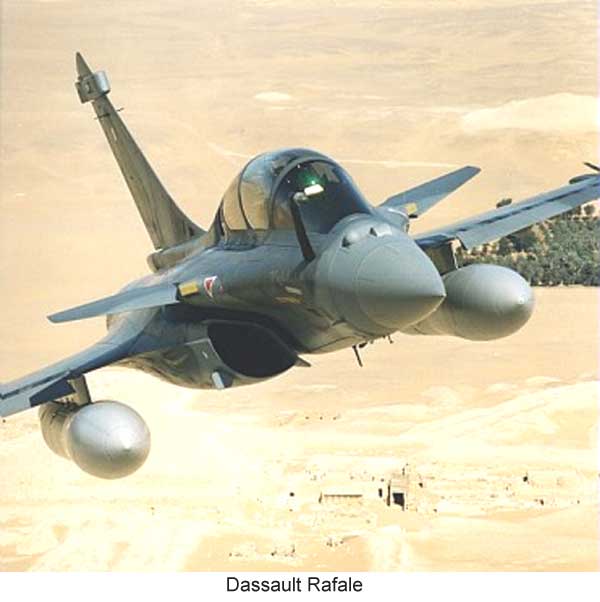The MMRCA as a first step, will enable the IAF to hold its own against the PAF, and when it reaches its authorised strength, to face the PLAAF. The technical evaluation process has been transparent and gone on without a hitch. The AESA radar that the IAF had specified, will be a game changer not only for air combat but equally well during air-to ground operations. Finally, in the area of potential benefits, transfer of technology will enable India to realise her full potential in designing and manufacturing combat jets. The cost of each of these aircraft will be high, but if the Indian negotiators do their job well, the future is assured for the IAF and India.
The process of selection of the vendor in the medium multi-role combat aircraft (MMRCA) contract is in the final stages with only two contenders, the Eurofighter Typhoon and the Dassault Rafale remaining in the competition. Which of the two combat aircraft will the Indian Air Force (IAF) finally induct as the MMRCA is the question that is foremost in the public mind?
Depleting Force Levels
The MMRCA proposal comes as challenges to India’s national security are increasing in intensity and complexity. IAF’s force levels have plummeted to an all-time low of 29 squadrons on account of normal attrition, retirement of obsolescent aircraft and interminable delay is the procurement of replacements. The currently authorised force level of 39.5 squadrons is unlikely to be restored before 2020. As India’s neighbors are aggressively modernising their air forces, the need to enhance the combat potential of the IAF acquires urgency.
There are a number of factors that influence the selection of the MMRCA. The growing size and strength of the Pakistan Air Force (PAF) and of China’s Peoples Liberation Army Air Force (PLAAF) has a direct bearing on the numbers, and the quality of the MMRCA as would also facilitate understanding of the rationale for the MMRCA, its attributes and its impact on the IAF.
The Impact of Air Power
The basic characteristics of air power are speed, reach, flexibility, mobility and lethality. Presently, even when India’s land forces possess far greater combat capability than they ever did, the IAF is still viewed as the principal rapid response component of Indian military power. In the prevailing scenario the possibility of limited war under the nuclear shadow being more likely, the role of the IAF has become even more critical.
In numerical terms, the IAF has to confront two adversaries, Pakistan and China, who routinely maintain close to 700 combat aircraft equivalent to the IAFs own strength…
Indian air power therefore, must be potent enough to achieve air superiority to permit the three services to successfully carry out their assigned missions. For such a strategy to be successful, requires the IAF to maintain significant quantitative and qualitative superiority against Pakistan and sufficiently dissuasive power against China. India successfully managed to maintain superiority in force levels throughout the 1980s with a 2.9:1 advantage in combat aircraft over Pakistan. The current shortfall in combat potential has cut deeply into the comprehensive air superiority essential to India’s military strategy.
The PAF
Pakistan has managed to maintain its combat aircraft inventories, thanks to the support from the US and China. The PAF has 22 combat squadrons against the IAF’s 29. The IAF has around 630 combat aircraft, which, in comparison with Pakistan’s 380-odd fighters, constitutes a ratio of 1.6:1, clearly a far cry from the 2.9:1 superiority that the IAF enjoyed in the 1980s.
 The qualitative changes in the PAF make these numbers even more troubling. Pakistan is acquiring new F-16C/D Block 50/52 aircraft with advanced radars, electronic warfare (EW) systems, and advanced aerial weapon systems. Finances permitting, the PAF could have a 100-strong contingent of advanced F-16s in the coming decade. PAF is also scheduled to acquire 250 new Chinese FC-1/JF-17 aircraft which will form the core of its future combat capability. The F-16 and the JF-17 fleets together could constitute a force of some 350 respectable fourth-generation combat aircraft armed with advanced sensors and air-to-air weaponry.
The qualitative changes in the PAF make these numbers even more troubling. Pakistan is acquiring new F-16C/D Block 50/52 aircraft with advanced radars, electronic warfare (EW) systems, and advanced aerial weapon systems. Finances permitting, the PAF could have a 100-strong contingent of advanced F-16s in the coming decade. PAF is also scheduled to acquire 250 new Chinese FC-1/JF-17 aircraft which will form the core of its future combat capability. The F-16 and the JF-17 fleets together could constitute a force of some 350 respectable fourth-generation combat aircraft armed with advanced sensors and air-to-air weaponry.
The PAF is also in the process of acquiring Beyond Visual Range Air-to- Air Missile (BVR AAM) capability for its fighter fleet, a lethal weapon system she did not possess earlier. These are the American AIM 120-C Advanced Medium Air-to Air Missile (AMRAAM) to arm the F-16C. The Chinese PL-12 (BVR AAM) for the new JF-17 Chinese jets, will allow the PAF to contest the Russian R-77 BVR AAMs, on board the Indian MiG-21 BISON and Su-30 MKI fighters. The PAF is also acquiring Airborne Early Warning (AEW) platforms, composed of four Swedish SAAB-2000 aircraft equipped with the ERIEYE phased array radar and four additional Y-8 AEW platforms from China. These acquisitions will enhance PAF’s air surveillance envelope, improve survivability of ground-based air defence network and enable combat aircraft to operate more effectively in both defensive and offensive missions against India.
This force structure reveals that the PLAAF will have more fourth generation aircraft a decade from now than the total number of aircraft in the IAF inventory.
The IAF still enjoys significant advantages over the PAF. It has a larger contingent of high performance aircraft; operates more BVR capable platforms ; its airplanes deploy better on-board sensors and electronic warfare systems; its pilots are more proficient in advanced air combat tactics including operations in a BVR environment. The IAF possesses superior combat support aircraft, better infrastructure and a continually improving integrated air defence network. However, India’s falling numbers of front-line combat aircraft will enhance risks and curtail flexibility. While these limitations will be less significant if the scale of conflict remains limited, they will become critical in the event of a large-scale war.
The PLAAF
The PLAAF has traditionally outnumbered the IAF by an order of magnitude. In the early 1990s, the Chinese air force inventory was huge, consisting of around 5,000 airplanes. From the IAF’s perspective, this threat was manageable because the backbone of its combat capability consisted of about 3,000 obsolete second-generation fighters such as the J-6/MiG-19. Third-generation fighters particularly the J-7 E/G and the J-8, were few. The J-7 fleet included roughly 500 aircraft in varying configurations and the J-8s probably never exceeded 100 airplanes in the PLAAF inventory.
 The most capable combat component of the PLAAF was probably smaller than the IAF’s combat fleet for decades after 1971. Furthermore, the PLAAF’s poor combat support aircraft inventory, primitive integrated air defence system, left the force as a whole, a poor challenger to the IAF. India had an even better advantage in this regard as the PLAAF’s best airplanes were deployed mostly along its northern and eastern borders, against Russia, Taiwan and Japan. Also, Chinese air bases in the Tibetan region were extremely primitive. I Infrastructure available on the Tibetan plateau was inadequate to support any significant air operations against India. The balance of air power persisted until the year 2000 when on account of a concerted modernisation initiated in the 1990s, the largely obsolescent combat inventory was replaced by modern more capable platforms. Accordingly, the PLAAF inventory has shrunk dramatically from the 5,000 combat aircraft during the 1990s to 1,700 today.
The most capable combat component of the PLAAF was probably smaller than the IAF’s combat fleet for decades after 1971. Furthermore, the PLAAF’s poor combat support aircraft inventory, primitive integrated air defence system, left the force as a whole, a poor challenger to the IAF. India had an even better advantage in this regard as the PLAAF’s best airplanes were deployed mostly along its northern and eastern borders, against Russia, Taiwan and Japan. Also, Chinese air bases in the Tibetan region were extremely primitive. I Infrastructure available on the Tibetan plateau was inadequate to support any significant air operations against India. The balance of air power persisted until the year 2000 when on account of a concerted modernisation initiated in the 1990s, the largely obsolescent combat inventory was replaced by modern more capable platforms. Accordingly, the PLAAF inventory has shrunk dramatically from the 5,000 combat aircraft during the 1990s to 1,700 today.
Along with the J-7s and J-8s, a smaller but rapidly growing fleet of advanced combat aircraft—over 350-odd fighters presently—the most prominent of which are, the Russian Su-27/30 and the indigenous F-10 which incorporates Israeli technology. The strength of the PLAAF will probably be around 1,700 aircraft in 2020, the proportion of advanced systems will keep increasing. It would be reasonable to expect PLAAF to have close to 500 Su-27/30s and 500 F-10s, as well as a small number of fifth-generation stealth fighters. The rest of the fleet would c consist of 300 F-7 and F-8 aircraft along with lightweight fighters –FC-1/JF-17 aircraft.
This force structure reveals that the PLAAF will have more fourth generation aircraft a decade from now than the total number of aircraft in the IAF inventory. This fleet would be armed with advanced AAMs like the PL-12 BVR AAM and would be supplemented with superior air-to-ground weapons, advanced EW systems, tanker support aircraft and advanced UAVs.
The up gradation is certain to result in a very capable air defence system, comprising comprehensive sensors, secure communication and data links, a robust command and control system and advanced SAMs. The large investments in intelligence, surveillance and reconnaissance (ISR) systems, space capabilities and cyber warfare have already attracted widespread attention. China is well on its way to becoming a genuine aerospace power rather than being merely an air force with high performance aircraft.
The situation is now clearer with the IAF needing to augment force levels initially by 126 MMRCA subsequently increasing to 200, and restoring the authorised level of 39.5 squadrons.
These improvements are also steadily becoming manifest in Southwestern China, which borders India. This region deploys 300 combat aircraft. The quality of this force has steadily improved with the deployment of fourth-generation aircraft such as the Su-27 and the F-10. Chinese capabilities in the Tibetan plateau has seen improvements in roads, railways, airfield infrastructure and fuel supply. The high elevation of the Tibetan plateau will entail reduced take-off weight restricting weapon load. This handicap can be partially offset through in-flight refueling. Unless India acts to stem the reduction in force levels of its fighter fleet, the IAF will face critical challenges.
In numerical terms, the IAF has to confront two adversaries, Pakistan and China, who routinely maintain close to 700 combat aircraft—equivalent to the IAF’s own strength—in the territorial regions contiguous to the Indian border. Although Indian superiority over Pakistani air power will continue in the foreseeable future. However, superiority of the IAF will diminish as the capability of the PAF improves. China poses a greater challenge. Not only is the IAF poised to lose forever its traditional numerical superiority where advanced combat aircraft are concerned, this segment of the PLAAF alone is likely to exceed the size of the entire IAF by 2020. When the larger transformation of the Chinese military is taken into account, the situation becomes serious indeed.
In terms of pure numbers, by 2020, the IAF will have to confront around 1,500 fourth- generation Pakistani and Chinese fighters not to mention cruise missiles, UAVs, ballistic missiles, electronic warfare, cyber and space warfare.






Nice post
That is the best blog for anybody who needs
to find out about this topic. You
understand so much its almost laborious to
argue with you (not that I actually would need…HaHa).
You undoubtedly put a brand new spin on a topic thats been written about for years.
Nice stuff, simply great!
I am so ready to understand why. In this article is the sort
of manual that has to be given and not just the
random misinformation that’s at the other blogs. Thank you for your sharing this best doc.